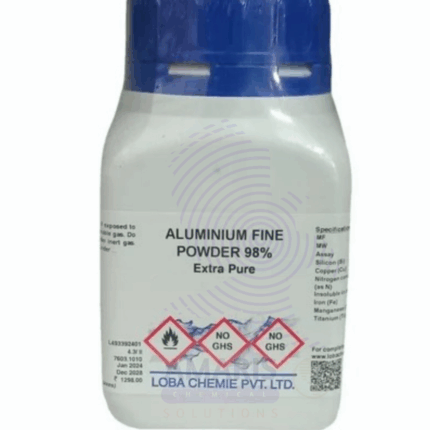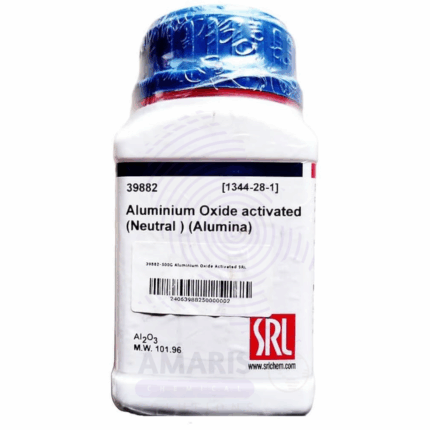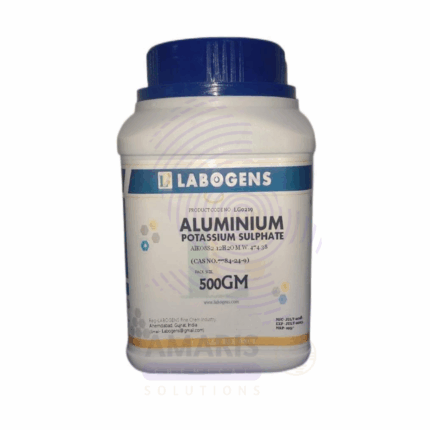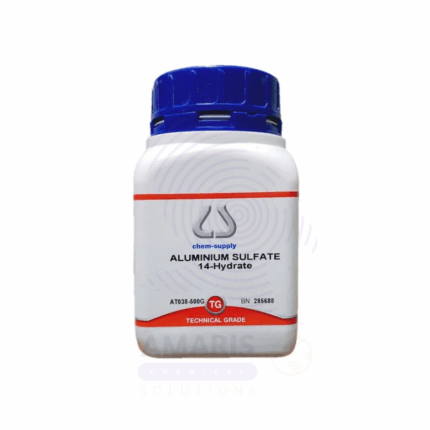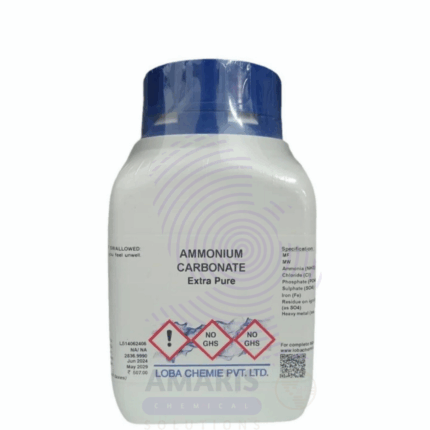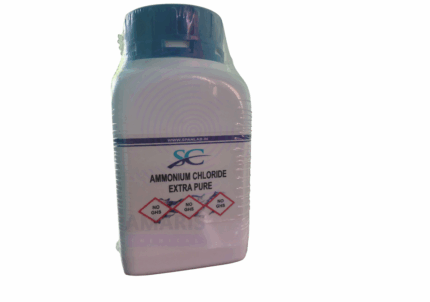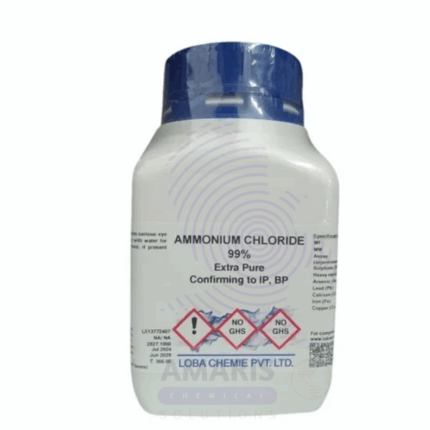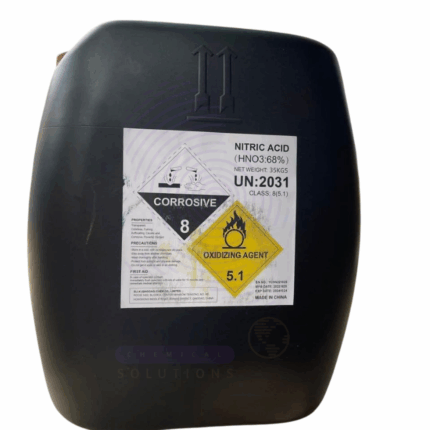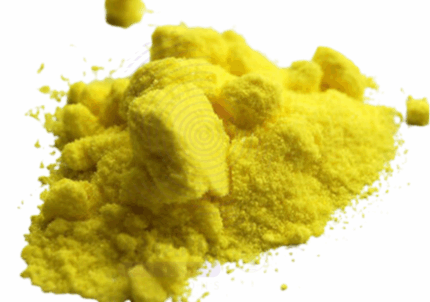
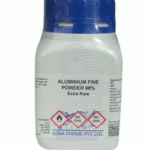
Aluminium Nitrate Extra Pure
$ 23.00 Original price was: $ 23.00.$ 22.54Current price is: $ 22.54.
Aluminium Nitrate Extra Pure is a high-purity, white crystalline compound that is highly soluble in water and widely used in laboratory chemistry for analytical, synthesis, and research purposes. It serves as a reliable source of aluminum ions in solution, making it valuable in qualitative analysis, coordination chemistry, and materials science studies. This compound is often utilized in the preparation of other aluminum salts, as a nitrating agent, and in controlled oxidation reactions. Its extra pure grade guarantees minimal interference from contaminants, ensuring accurate, reproducible results in sensitive experimental work. Aluminium Nitrate should be stored in tightly sealed containers, away from moisture and incompatible substances, due to its oxidizing nature and hygroscopicity.
Aluminium Nitrate Extra Pure
Primary Uses
- Reagent in Inorganic Analysis
- Supplies aluminum ions in qualitative analysis; used to identify reactions with hydroxides, carbonates, or sulfates.
- Precursor in Synthesis of Other Aluminium Compounds
- Used to prepare aluminum hydroxide, alumina (Al₂O₃), or complex salts under controlled conditions.
- Catalyst Precursor in Material Science
- Acts as a starting material for lab-scale catalyst preparation, including mixed metal oxides and supported catalysts.
- Standard for Nitrate Ion Studies
- Offers both aluminum and nitrate ions, useful in studying ionic behavior, solubility, and hydrolysis in aqueous systems.
- pH & Hydrolysis Experiments
- Demonstrates hydrolysis of metal salts and resulting pH changes, ideal for acid-base or buffer studies.
Secondary Uses
- Thermal Decomposition Studies
- Decomposes to aluminum oxide, nitrogen oxides, and oxygen—useful in thermogravimetric and decomposition research.
- Flame Test & Spectroscopy Calibration
- Provides a source of Al³⁺ ions for testing flame color or calibrating spectroscopy instruments.
- Environmental Chemistry Simulations
- Used in studies modeling aluminum mobility and nitrate behavior in soils or aquatic systems.
- Precipitation & Crystallization Demonstrations
- Forms well-defined precipitates with hydroxides or fluorides, useful in teaching solubility principles.
- Fuel-Oxidizer Compositions (Research Use Only)
- Investigated in energetic material studies as an oxidizing salt component in controlled formulations.
| PACK SIZE |
500 grams Plastic Tin |
|---|
1. Basic Identification Attributes
- Chemical Name: Aluminium Nitrate Nonahydrate (IUPAC: Aluminium trinitrate nonahydrate)
- CAS Number: 7784-27-2
- HS Code: 28342990 (Other nitrates)
- Molecular Formula: Al(NO₃)₃·9H₂O
- Synonyms:
- Aluminium(III) nitrate nonahydrate
- Nitric acid, aluminium salt, nonahydrate
- Trinitrate of aluminium
- AlN₃O₉·9H₂O
2. Physical & Chemical Properties
- Physical State: Solid (crystalline powder)
- Color & Odor: White crystals; odorless
- Boiling Point: Decomposes (no boiling point)
- Melting Point: ~73°C (with decomposition and water loss)
- Density/Specific Gravity: ~1.72 g/cm³
- Solubility:
- Water: Very soluble (forms strongly acidic solution)
- Alcohol: Soluble
- pH Level: ~2.5–3.5 (in 5% solution – acidic)
- Vapor Pressure & Volatility: Non-volatile
- Flash Point: Not flammable
- Autoignition Temperature: Not applicable
- Viscosity: Not applicable (solid)
3. Safety & Hazard Attributes
- Hazard Class (GHS):
- Oxidizing Solid (Category 3)
- Eye Irritation (Category 2A)
- Skin Irritation (Category 2)
- NFPA Ratings:
- Health: 2
- Flammability: 0
- Reactivity: 2 (oxidizer)
- Exposure Limits:
- No specific OSHA PEL or ACGIH TLV
- Handle as oxidizing nitrate compound
- Reactivity:
- Strong oxidizer
- Incompatible with reducing agents, combustible materials, and strong acids/bases
4. Storage & Handling Attributes
- Storage Conditions:
- Store in cool, dry place in tightly sealed containers
- Keep away from combustible materials and moisture
- Incompatible Materials:
- Organic materials, reducing agents, sulfides, phosphides, powdered metals
- Container Type:
- Non-metal, non-combustible, airtight containers (glass or HDPE)
- Shelf Life & Expiration Date:
- ~2 years if sealed and moisture-free
- Special Handling Requirements:
- Use gloves, goggles, and lab coat
- Avoid dust generation; use fume hood for weighing and dissolution
5. Regulatory & Compliance Attributes
- Regulatory Status:
- Listed under TSCA, REACH
- Controlled as oxidizing compound
- Transportation Restrictions:
- UN Number: UN1438
- Hazard Class: 5.1 (Oxidizing substance)
- Packing Group: III
- Waste Disposal Method:
- Neutralize with reducing agent under controlled conditions
- Dispose of as hazardous oxidizing waste in accordance with local guidelines
6. Environmental & Health Impact
- Ecotoxicity:
- Harmful to aquatic life in high concentrations
- Increases nitrate levels in water systems
- Persistence in Environment:
- Dissolves and disassociates readily; contributes to nutrient loading
- Carcinogenicity/Mutagenicity:
- Not classified as carcinogenic or mutagenic
- Biodegradability:
- Inorganic compound; not biodegradable
SAFETY PRECAUTIONS
- Personal Protective Equipment (PPE):
- Wear lab coat, chemical-resistant gloves (e.g., nitrile), and safety goggles.
- Use a dust mask or respirator if powder becomes airborne.
- Handling:
- Handle in a well-ventilated area or under a fume hood.
- Avoid contact with eyes, skin, and clothing.
- Keep away from combustible materials—aluminium nitrate is a strong oxidizer and can intensify fire.
- Storage:
- Store in a tightly sealed container in a cool, dry, well-ventilated area.
- Keep away from heat, flammable substances, and reducing agents.
- Segregate from organic materials, sulfur, powdered metals, and acids.
- Hygiene Measures:
- Wash hands thoroughly after handling.
- Avoid eating, drinking, or smoking in lab areas.
- Decontaminate surfaces after use.
FIRST AID MEASURES
- Inhalation:
- Move the person to fresh air immediately.
- If breathing is difficult, provide oxygen.
- Seek medical attention if symptoms persist (e.g., coughing, shortness of breath).
- Skin Contact:
- Remove contaminated clothing.
- Rinse affected areas with soap and water for at least 15 minutes.
- Seek medical advice if irritation occurs.
- Eye Contact:
- Immediately flush eyes with water for at least 15 minutes, holding eyelids apart.
- Remove contact lenses if present and easy to do.
- Seek immediate medical attention.
- Ingestion:
- Rinse your mouth thoroughly with water.
- Do not induce vomiting.
- Seek immediate medical attention.
- May cause irritation to the gastrointestinal tract and can be harmful in large amounts.
FIRE FIGHTING MEASURES
- Suitable Extinguishing Media:
- Use water spray, dry chemical, or carbon dioxide (CO₂).
- Do not use dry combustibles near the fire (e.g., sawdust or paper).
- Specific Hazards:
- Not flammable, but acts as a strong oxidizer—may cause or intensify fire in contact with flammable materials.
- Thermal decomposition can release toxic gases such as nitrogen oxides (NOₓ) and aluminum oxides.
- Protective Equipment for Firefighters:
- Wear full protective clothing and self-contained breathing apparatus (SCBA).
- Firefighting Instructions:
- Isolate and cool containers with water spray.
- Fight fire from a safe distance and avoid inhaling combustion products.
- Prevent contamination of water sources.
Related products
Aluminium Metal Fine Extra Pure
Aluminium Oxide Active Neutral Extra Pure
Aluminium Potassium Sulphate Hydrated Extra Pure
Aluminium Sulphate Hydrous Extra Pure
Ammonium Carbonate Extra Pure
Ammonium Carbonate Extra Pure is a high-quality, white crystalline solid widely used across various scientific, industrial, and food-related applications. Manufactured to stringent purity standards, this compound is ideal for laboratories and processes that demand high-grade reagents. With its characteristic ammonia-like odor and ability to decompose upon heating, ammonium carbonate plays a versatile role in both chemical reactions and physical processes.
In aqueous solution, ammonium carbonate breaks down into ammonium bicarbonate and ammonium carbamate, further releasing ammonia (NH₃) and carbon dioxide (CO₂) upon heating. This property makes it especially useful in applications that require controlled gas release or temporary pH modification.


 Preservatives(food)
Preservatives(food) Flavor Enhancers
Flavor Enhancers Acidulants
Acidulants Sweeteners
Sweeteners Antioxidants
Antioxidants Colorants(food)
Colorants(food) Nutraceutical Ingredients (food)
Nutraceutical Ingredients (food) Nutrient Supplements
Nutrient Supplements Emulsifiers
Emulsifiers
 Collectors
Collectors Dust Suppressants
Dust Suppressants Explosives and Blasting Agents
Explosives and Blasting Agents Flocculants and Coagulants
Flocculants and Coagulants Frothers
Frothers Leaching Agents
Leaching Agents pH Modifiers
pH Modifiers Precious Metal Extraction Agents
Precious Metal Extraction Agents
 Antioxidants(plastic)
Antioxidants(plastic) Colorants (Pigments, Dyes)
Colorants (Pigments, Dyes) Fillers and Reinforcements
Fillers and Reinforcements Flame Retardants
Flame Retardants Monomers
Monomers Plasticizers
Plasticizers Polymerization Initiators
Polymerization Initiators Stabilizers (UV, Heat)
Stabilizers (UV, Heat)
 Antifoaming Agents
Antifoaming Agents Chelating Agents
Chelating Agents Coagulants and Flocculants
Coagulants and Flocculants Corrosion Inhibitors
Corrosion Inhibitors Disinfectants and Biocides
Disinfectants and Biocides Oxidizing Agents
Oxidizing Agents pH Adjusters
pH Adjusters Scale Inhibitors( water)
Scale Inhibitors( water)
 Antioxidants(cosmetic)
Antioxidants(cosmetic) Emollients
Emollients Fragrances and Essential Oils
Fragrances and Essential Oils Humectants
Humectants Preservatives
Preservatives Surfactants(cosmetic)
Surfactants(cosmetic) Thickeners
Thickeners UV Filters
UV Filters
 Fertilizers
Fertilizers Soil Conditioners
Soil Conditioners Plant Growth Regulators
Plant Growth Regulators Animal Feed Additives
Animal Feed Additives Biostimulants
Biostimulants Pesticides (Herbicides, Insecticides, Fungicides)
Pesticides (Herbicides, Insecticides, Fungicides)
 Active Pharmaceutical Ingredients (APIs)
Active Pharmaceutical Ingredients (APIs) Excipients
Excipients Solvents(pharmaceutical)
Solvents(pharmaceutical) Antibiotics
Antibiotics Antiseptics and Disinfectants
Antiseptics and Disinfectants Vaccine Adjuvants
Vaccine Adjuvants Nutraceutical Ingredients (pharmaceutical)
Nutraceutical Ingredients (pharmaceutical) Analgesics & Antipyretics
Analgesics & Antipyretics
 Analytical Reagents
Analytical Reagents Solvents(lab)
Solvents(lab) Chromatography Chemicals
Chromatography Chemicals Spectroscopy Reagents
Spectroscopy Reagents microbiology-and-cell-culture-reagents
microbiology-and-cell-culture-reagents Molecular Biology Reagents
Molecular Biology Reagents Biochemical Reagents
Biochemical Reagents Inorganic and Organic Standards
Inorganic and Organic Standards Laboratory Safety Chemicals
Laboratory Safety Chemicals Specialty Laboratory Chemicals(Special Laboratory Equipment)
Specialty Laboratory Chemicals(Special Laboratory Equipment)
 Demulsifiers
Demulsifiers Hydraulic Fracturing Fluids
Hydraulic Fracturing Fluids Scale Inhibitors(oil)
Scale Inhibitors(oil) Surfactants(oil)
Surfactants(oil) Drilling Fluids
Drilling Fluids
 Dyes and Pigments
Dyes and Pigments Bleaching Agents
Bleaching Agents Softening Agents
Softening Agents Finishing Agents
Finishing Agents Antistatic Agents
Antistatic Agents
 Admixtures
Admixtures Waterproofing Agents
Waterproofing Agents Sealants and Adhesives
Sealants and Adhesives Curing Compounds
Curing Compounds Concrete Repair Chemicals
Concrete Repair Chemicals Anti-Corrosion Coatings
Anti-Corrosion Coatings
 Surfactants(cleaning)
Surfactants(cleaning) Builders
Builders Enzymes
Enzymes Solvents (Cleaning)
Solvents (Cleaning) Fragrances
Fragrances
 Electronic Chemicals
Electronic Chemicals Catalysts
Catalysts Lubricants
Lubricants Photographic Chemicals
Photographic Chemicals Refrigerants
Refrigerants Automotive chemicals
Automotive chemicals Pyrotechnic Chemicals
Pyrotechnic Chemicals
 Biodegradable Surfactants
Biodegradable Surfactants Bio-based Solvents
Bio-based Solvents Renewable Polymers
Renewable Polymers Carbon Capture Chemicals
Carbon Capture Chemicals Wastewater Treatment Chemicals
Wastewater Treatment Chemicals
 Pigments
Pigments Solvents(paint)
Solvents(paint) Specialty Coatings
Specialty Coatings Binders/Resins
Binders/Resins Additives
Additives Driers
Driers Anti-Corrosion Agents
Anti-Corrosion Agents Functional Coatings
Functional Coatings Application-Specific Coatings
Application-Specific Coatings
 Fresh Herbs
Fresh Herbs Ground Spices
Ground Spices Whole Spices
Whole Spices Spice Blends
Spice Blends Dried Herbs
Dried Herbs
 Leavening Agents
Leavening Agents Dough Conditioners
Dough Conditioners Flour Treatments
Flour Treatments Fat Replacers
Fat Replacers Decoratives
Decoratives Preservatives(baking)
Preservatives(baking)
 Plasticizers & Softeners
Plasticizers & Softeners Reinforcing Agents
Reinforcing Agents Adhesion Promoters
Adhesion Promoters Vulcanizing Agents
Vulcanizing Agents Antidegradants
Antidegradants Blowing Agents
Blowing Agents Fillers & Extenders
Fillers & Extenders Accelerators & Retarders
Accelerators & Retarders

